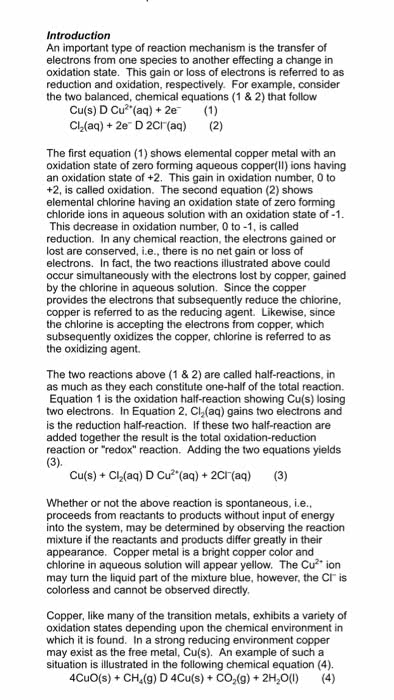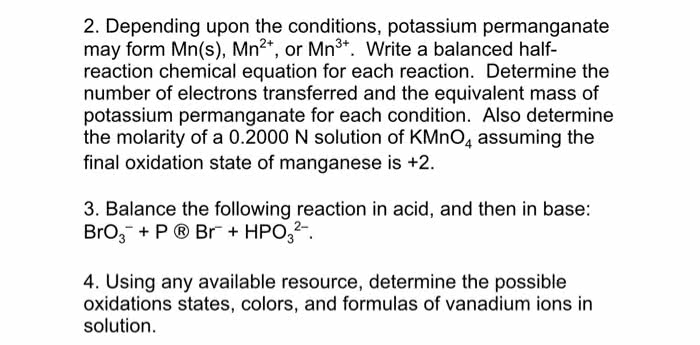1. (1 point) What are transferred in an oxidation-reduction reaction? *
⢠atoms
⢠electrons
⢠ions
⢠protons
2. (1 point) In the reaction of beryllium with fluorine, which atom is oxidized? *
⢠fluorine
⢠beryllium
⢠neither of them
⢠both of them
3. (1 point) Ag - - > Ag ^+ +1 e^- This equation represents the type of reaction called _____. *
⢠hydrolysis
⢠oxidation
⢠redox
⢠reduction
4. (1 point) What is the reducing agent in the following reaction? 2K + S - - > K2S *
⢠K
⢠S
⢠K2S
⢠None of the above
5. (1 point) The oxidation number of oxygen when it is in a compound other than a peroxide is ____. *
⢠-2
⢠-1
⢠0
⢠+2
6. (1 point) What is the oxidation number for each atom in NH4F? *
⢠N=+3, H=-4, F=+1
⢠N=-3, H=+1, F=-1
⢠N=+3, H+1, F=-1
⢠N=-3, H=-1, F=+1
7. (1 point) Which atom has a change in oxidation number of +4 in the following redox reaction?K2Cr2O7 + H2O + S - - > KOH + Cr2O3 + SO2 *
⢠K
⢠Cr
⢠O
⢠S
Metal activity series for question 8
8. (1 point) Of the following metals, which ions are most easily reduced? Use the above table to answer the question. *
⢠magnesium
⢠lead
⢠copper
⢠sodium
9. (1 point) In a zinc-copper cell, Zn(s) | Zn^+2(1M) || Cu^+2(1M) | Cu(s), which electrode is positive? *
⢠Cu^+2
⢠Cu(s)
⢠Zn(s)
⢠Zn^+2
10. (1 point) How must a redox reaction that is to be used as a source of electrical energy be set up? *
⢠One half reaction must involve two metals.
⢠Two half reactions must use a metal wire electrodes.
⢠One half reactions must involve more than one electron.
⢠Two half reactions must be physically separated.
11. (1 point) In a voltaic cell at which electrode does reduction occur? *
⢠anode only
⢠cathode only
⢠both anode and cathode
⢠Either anode or cathode , depending on the metal
12. (1 point) What assures that there is no charge build up in a voltaic cell as oxidation and reduction occur? *
⢠one of the half cells
⢠the electrolyte solutions
⢠the moving electrons
⢠the salt bridge
13. (1 point) In the most common dry cell what material is the electrode that is the center rod made of? *
⢠copper
⢠graphite
⢠lead
⢠zinc
14. (1 point) To charge a lead storage battery you must ________. *
⢠apply a direct current to it.
⢠hold a magnet close to it.
⢠Use alternating current through it.
⢠increase the oxygen in it.
15. (1 point) In a hydrogen- oxygen fuel cell ______________. *
⢠hydrogen diffuses through the cathode.
⢠hydrogen and oxygen are mixed before entering the anode.
⢠oxygen diffuses through the anode.
⢠oxygen diffuses through the cathode.
16. (1 point) When electrical energy is used to cause a chemical reaction we call this process _____. *
⢠electronation
⢠electrolysis
⢠hydration
⢠reduction
17. (1 point) Which of the following is true about an electrolytic cell? *
⢠It changes chemical energy into electrical energy.
⢠It is the type of cell used in electrocution
⢠It uses an electric current to make a nonspontaneous reaction go.
⢠All of the above
18. (1 point) The products formed in the net reaction of the electrolysis of water are ____. *
⢠aqueous hydrogen ion and hydroxyl ion
⢠hydrogen gas and oxygen gas
⢠hydrogen gas and liquid oxygen
⢠water vapor
19. (1 point) What occurs in electroplating? *
⢠decomposition of an ionic compound
⢠decomposition of a salt layer
⢠deposition of a metal layer on a material
⢠deposition of a salt layer on a metal
Open response Questions : Answer questions 20 through 22 in complete sentences
20. ( 5 points) Write the equation for the reaction of calcium and oxygen ( 1 point). Write the oxidation numbers for both the reactants and the products ( 2 points) What is the reducing agent and why? ( 2 points)
21. ( 5 points) Tell how a voltaic cell works. Be sure to mention the various parts of the voltaic cell and what they have to do with how it works.
22. (4 points) What are the signs given to the electrodes in both the voltaic and electrolytic cells? What reaction (oxidation or reduction) is occurring at each?







